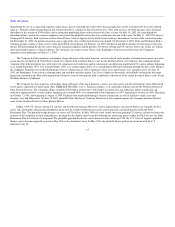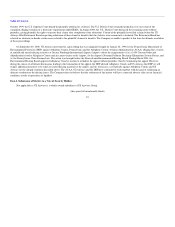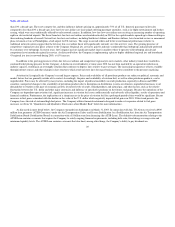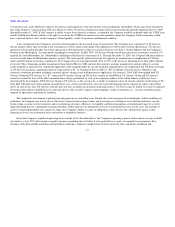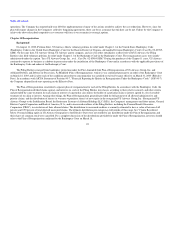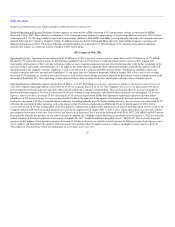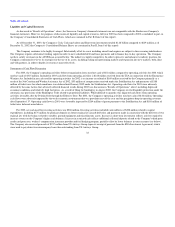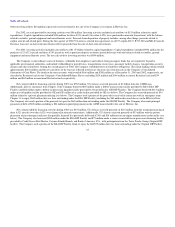US Airways 2003 Annual Report Download - page 30
Download and view the complete annual report
Please find page 30 of the 2003 US Airways annual report below. You can navigate through the pages in the report by either clicking on the pages listed below, or by using the keyword search tool below to find specific information within the annual report.
Table of Contents
revenue for 2003 includes a favorable $34 million adjustment to the traffic balances payable account for unused and now expired tickets. Other operating
revenue was flat as increased mileage credit sales were offset by lower ticket change and cancellation fees.
Operating Expenses–Operating expenses declined by $1.23 billion, or 14.9%. Operating expenses excluding Government compensation and Asset
impairments and other special items were lower by 9.2% on a capacity decrease (as measured by available seat miles or ASMs) of 6.9%. Personnel costs
decreased 19.4% due to lower headcount levels, wage rates and employee pension and benefit expenses partially offset by $125 million of stock-based
compensation expenses resulting from the issuance of common stock to employees covered by collective bargaining agreements following emergence from
Chapter 11. Aviation fuel increased 6.6% due to higher average fuel prices partially offset by schedule-driven decreases in consumption. US Airways Express
capacity purchases increased 4.7% reflecting a 9.3% increase in purchased ASMs from third-party regional jet operators and other airline subsidiaries of US
Airways Group. Aircraft rent decreased 15.0% due to favorably restructured leases and lease rejections made in connection with the Company's Chapter 11
filing, which was partially offset by new leases as a result of the conversion of mortgaged aircraft to leased aircraft. Other rent and landing fees were flat as a
result of schedule-driven decreases in landing fees offsetting increased airport rental expenses associated with the new terminal in Philadelphia. Selling
expenses decreased 6.0% due to sales volume driven decreases in credit card fees and sales- and rate-driven decreases in computer reservation system fees.
Travel agent commission rates decreased due to the elimination of the base domestic commissions in March 2002 and increases in internet bookings which are
less costly to the Company. Depreciation and amortization decreased 21.5% due to fewer owned aircraft in the operating fleet and lower book values on the
existing fleet as a result of fresh-start reporting. Other operating expenses decreased 9.8% due to decreases in insurance expenses and schedule-related
expenses including passenger food expenses and crew travel expenses and a $17 million and $12 million reduction to an accrual upon the resolution of
previously outstanding contingencies. Refer to "Description of Unusual Items" below for information on Asset impairments and other special items and
Government compensation.
Other Income (Expense)–Other Income (Expense), net increased $2.3 billion from an expense of $593 million in 2002 to income of $1.7 billion in 2003. The
increase is primarily due to $1.9 billion of income as a result of Reorganization items, net. Interest income decreased due to lower return rates partially offset
by higher average investment balances. Interest expense decreased as a result of the conversion of mortgaged aircraft to leased aircraft and the abandonment
of certain aircraft partially offset by interest related to the ATSB Loan. Other, net income increased as a result of a $30 million gain recognized in connection
with the Company's sale of its investment in Hotwire, Inc. and mark-to-market adjustments on certain stock options held by the Company. Refer to
"Description of Unusual Items" below for information on Reorganization items, net.
Provision (Credit) for Income Taxes–The Company's federal and state income tax expense was $6 million in 2003 representing an effective tax rate of 0.4%.
This differed from statutory rates primarily due to utilization of net operating loss carryforwards. During 2001, the Company recognized a valuation
allowance against its net deferred tax asset. The Company continues to record a full valuation allowance against its net deferred tax assets due to the
uncertainty regarding their ultimate realization. As a result of the March 2002 enactment of the Job Creation and Worker Assistance Act of 2002 (Job Act),
the Company recognized an income tax credit equal to the Company's carryback potential. The Job Act provides, among other things, an extension of the net
operating loss carryback period to five years from two years for net operating losses arising from tax years that end in 2001 or 2002 and the elimination of the
90% limitation for alternative minimum tax purposes on those loss carrybacks. The tax credit recorded in 2002 includes $53 million related to 2001 losses
realizable due to the enactment of the Job Act and recorded in the period of enactment. The Company continued to record a valuation allowance
25


